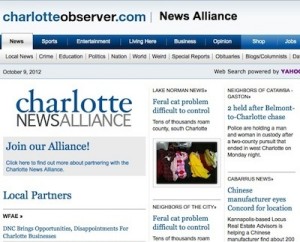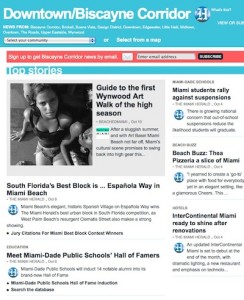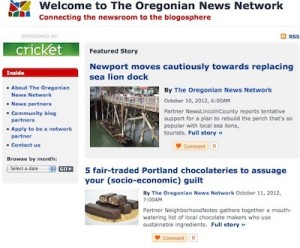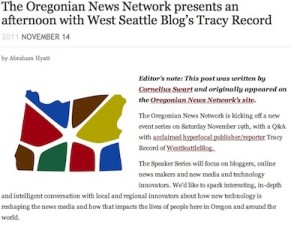“This has been hugely, hugely paradigm-changing for our newsroom, and for me individually… This whole notion that we would feature someone else’s content on our website and drive traffic off the site, that was such an alien notion at the time we took the leap on this.”
– David Boardman | Executive Editor, The Seattle Times
Three years ago, J-Lab launched the first round of what would turn out to be nine pilot projects in collaborative journalism in the United States. Now, the verdicts – and the lessons learned – are in.
There is good news and bad news. A majority of the projects delivered success far beyond our expectations and a notable level of creativity; others did yeoman’s work. And, unfortunately, a couple projects failed.
The various models for building the collaborations were astonishingly different. The epiphanies for many of the newsrooms at the hub of the activities were, in their own words, transformational.
 “I was enthusiastic about this, but I had no idea of how transformative this would be for us,” said David Shribman, editor of the Pittsburgh Post-Gazette, which launched the Pipeline site to cover fracking. “It changed the center of gravity for our whole organization.”
“I was enthusiastic about this, but I had no idea of how transformative this would be for us,” said David Shribman, editor of the Pittsburgh Post-Gazette, which launched the Pipeline site to cover fracking. “It changed the center of gravity for our whole organization.”
Said Seattle Times Editor David Boardman, “I think this program . . . has been hugely, hugely paradigm-changing for our newsroom and for me, individually.”
Bottom line: At its height, the nine hub newsrooms had grown their networks from 44 partners to 169; 146 partners are still participating.
We’ve learned, however, that all networks are iterative: Partners come and they go. Some divorce the network, some die in an emerging news ecosystem that is still quite fragile. Indeed, only two of the projects still have the identical partners they launched with.
The overall score: Five wins, two hits and two losses.
Two key takeaways: Content sharing overall can be a win-win for both legacy newsrooms and indie start-ups. Revenue sharing, however, is still a nut to be cracked.
 Many of the participating newsrooms have integrated partner contributions into their daily news flow. One site, The Seattle Times, has even created a weekly Sunday print page that highlights best partner stories of the previous week. Participating indie news partners requested, and received, substantial training in business, multimedia skills and journalism. Entire websites, such as North Coast Oregon or Villa Heights Voice in Charlotte, were created for communities that had no news coverage.
Many of the participating newsrooms have integrated partner contributions into their daily news flow. One site, The Seattle Times, has even created a weekly Sunday print page that highlights best partner stories of the previous week. Participating indie news partners requested, and received, substantial training in business, multimedia skills and journalism. Entire websites, such as North Coast Oregon or Villa Heights Voice in Charlotte, were created for communities that had no news coverage.
Traditional newsrooms got to share with their audiences stories of their communities that they no longer could cover on their own. Hyperlocal news sites got a megaphone for news that had been stuck in local silos. And news consumers were given some new ways to navigate their noisy local blogosphere.
With this report, we tell the stories of the individual projects and examine efforts to share content and monetize regional hyperlocal networks with advertising. The stories are drawn on interviews, project reports, presentations and correspondence – all with an eye to the lessons that can be learned.
These stories also offer early insights into some issues surfacing in the emerging news landscape: the “problem of news” to be solved, the rise of advocacy news sites, the tenuous nature of indie start-ups, the reality of sponsored content and the bandwidth available for innovation in legacy newsrooms.
The Networked Journalism (Net-J) project was funded with $500,000 from the Knight Foundation, and the foundation is to be credited for also supporting a second round of pilot projects.
Here’s How It Worked
In the Networked Journalism experiment, eight legacy newspapers and one public radio station were invited to partner with at least five independent news efforts in their community for at least a year. The first five pilot projects were extended with a small amount of additional funding for another year, in large part to see if they could monetize their network. In a second round, four more pilot sites were added.
 Left to design their own models, nine different approaches emerged, including two networks that focused on topics – fracking for natural gas and sports – rather than geography.
Left to design their own models, nine different approaches emerged, including two networks that focused on topics – fracking for natural gas and sports – rather than geography.
All but two of the participating legacy newsrooms had to overcome a fundamental, but overarching, tension: Could they really bring themselves to drive traffic off their own websites to stories appearing on other news sites in their community?
“This whole notion that we would feature someone else’s content on our website and drive traffic off the site, that was such an alien notion at the time we took the leap on this,” Seattle’s Boardman said.
 Jennifer Rothacker, The Charlotte Observer’s Innovations Editor, agreed. “There was a mind block in the newsroom to put headlines on charlotteobserver.com that would link to other sites. It took a long time for people to get their heads around that.”
Jennifer Rothacker, The Charlotte Observer’s Innovations Editor, agreed. “There was a mind block in the newsroom to put headlines on charlotteobserver.com that would link to other sites. It took a long time for people to get their heads around that.”

One site, The Miami Herald, avoided this by creating “channels” for participating partners on its own content management system. The other, the Lawrence Journal-World in Kansas, launched a whole content network to try to syndicate participants’ stories.
There were tensions as well for the independent news start-ups: As fledgling enterprises, how could they maintain their independence and participate without being big-footed by a major news organization in town? How much content could they share without hurting their own enterprises? Would they get enough traffic to make it worthwhile? Would an affiliation with a big-media partner in town undercut the very independence that many of their constituents love?
 “My neighborhood thinks The Seattle Times has a more conservative, more suburban view of the city. My people don’t like that,” said Justin Cardin, founder of Capitol Hill Seattle Blog.
“My neighborhood thinks The Seattle Times has a more conservative, more suburban view of the city. My people don’t like that,” said Justin Cardin, founder of Capitol Hill Seattle Blog.
First-year projects received $45,000 with $20,000 targeted to pay for a coordinator to help recruit and oversee the network, plus five $5,000 “thank-you” stipends to be awarded to the initial five participants. An additional $15,000 was awarded the following year to help focus on bringing in revenue.
In the second round, projects were awarded $50,000 to pay for a coordinator and provide training, and the individual sites were given leeway to determine the amount of partner stipends. Most of the second-year projects paid their partners less than $5,000 apiece.
The size of the partner stipend, however, did not correlate to the success of the project although some networks lost momentum when the funding ran out. “Without even a little carrot of grant money, it was a hard sell,” said Anthony Gimino, project coordinator for Tucson’s Sports Network.
Angie Newsome, The Asheville Citizen-Times’ project manager, said, the stipends paid “went a long way in building trust in the community and countering claims that the newspaper simply wanted content for free.”
Funding a part-time project coordinator, however, turned out to be a critical component for the high-touch activities needed to get the networks off the ground, and getting the right coordinator could make or break a project. Three of the original coordinators have since been hired full time by their newsrooms.
J-Lab issued the invitations based on prospects for partner candidates in the community and for leadership stability in the hub newsrooms. The Gannett Co. recommended two of its news outlets as partners, TucsonCitizen.com and The Asheville Citizen-Times.
Five of the partners are still going strong. Two had very strong starts and made it to second base, but by the third year are greatly diminished. Two are inactive.
Success stories include The Seattle Times, The Charlotte Observer, the Pittsburgh Post-Gazette, The Oregonian in Portland and KQED Public Radio in San Francisco. The Miami Herald and TucsonCitizen.com launched bold and promising networks, but only a handful of partners remain active. The Asheville Citizen-Times and Lawrence Journal-World got off to strong starts but didn’t make a go of it.
The Problem to be Solved
With U.S. newspapers losing more than 42,000 journalists since 2007, local news coverage has suffered. At the same time, hundreds of local blogs and news sites have launched in their markets. Some are covering neighborhoods or small towns; others are doing statewide accountability journalism. Still more are covering lifestyle topics such as the arts, food or the outdoors.
What role can traditional news organizations play not only to expose their audiences to more news than they themselves can deliver, but also to connect new sources of information rising throughout their communities?
 For Oregonian Editor Peter Bhatia it is aiming for a “big-tent” that makes the paper’s website “a central place for local news – however you define it.” The Oregonian News Network now has 48 partners.
For Oregonian Editor Peter Bhatia it is aiming for a “big-tent” that makes the paper’s website “a central place for local news – however you define it.” The Oregonian News Network now has 48 partners.
“We believe journalism can and should include a much broader range of coverage,” he said. “And we don’t necessarily think only our journalists can do that work.”
Some traditional news organizations think that no indie news sites in their communities are good enough to partner with. They fear they will dilute their brand if they associate with content providers who are not professional journalists.
But increasingly, news organizations are noticing that some of the new players are doing a pretty good job. “I believe these emerging news organizations are performing a valuable news service, reporting news I don’t see elsewhere, or reporting more deeply than our general-interest newspapers,” said Bruce Koon, news director of KQED Public Radio, which is now working with eight “news associates.”
The newsrooms that agreed to pilot these projects had different goals. Some wanted to juice content from bootstrapped websites for their beleaguered newspaper. Others wanted to validate and send traffic to indie news sites that might help monetize a network. The Oregonian wanted to create a “dynamic publishing and educational network.”
Secret Sauce for Success
What would a successful partnership look like? For Seattle, now with 54 partners, it was a loose confederation that would share tips and links, but not full stories, and abide by a one-page Memorandum of Understanding. For Charlotte, now with 18 partners, it was an iron-clad content licensing agreement that allowed partners to republish up to four full stories or photos a week. (View copies of available partnership agreements.)
To address quality and brand, many of the networks came up with content guidelines that urged daily updating, codified protocols for attribution and linking, prohibited copying of photos without permission, and barred creating stories in exchange for advertising sales.
Integral to success were the kinds of partners recruited to be in the network. Creators of original content were key. Quality and frequency of posts were important. Sites that were too local or too niche might not have enough appropriate content that other sites would want to share with their readers.
 Training also helped gel the networks, allowing partners to learn from others and feel like they were almost part of a club. Partners got training in how to sell ads, how to do video and audio, how to use social media, how to deep search – and more. Training however, could be challenging. It was often hard to convene partners who might be working other jobs during the day and covering community meetings at night.
Training also helped gel the networks, allowing partners to learn from others and feel like they were almost part of a club. Partners got training in how to sell ads, how to do video and audio, how to use social media, how to deep search – and more. Training however, could be challenging. It was often hard to convene partners who might be working other jobs during the day and covering community meetings at night.
To date, these pilot projects demonstrated that to design a genuine win-win for both a legacy newsroom and its community partners, two things are needed:
- It is the responsibility of the hub news organization to provide their news networks with enough visibility and outbound links to drive traffic to their partners’ sites.
- It is the responsibility of the community news partners to post frequently enough to be robust participants and to nab the visibility – either on the network page or the home page – that would bring them traffic.
 While there was no marketing or promotion money for these projects, many, in particular Pittsburgh’s Pipeline project, used social media. Some like the Oregonian developed a network logo and ran house ads featuring some of its partners. Others such as KQED put their partners on the air.
While there was no marketing or promotion money for these projects, many, in particular Pittsburgh’s Pipeline project, used social media. Some like the Oregonian developed a network logo and ran house ads featuring some of its partners. Others such as KQED put their partners on the air.
Generating Revenue
There were four different attempts to generate revenue among the pilot projects. The most organized involved a Seattle Times partnership with KING5 television to use their combined sales forces to develop an ad network for hyperlocal partners and split revenue. Within a year, they concluded they could not cover their costs. The Miami Herald actually created advertising spots on partner channels in its content management system that the partners could sell and keep the revenue. Few ads, however, were sold. The Lawrence Journal-World developed a new content network to sell stories and, it hoped, ads, but it never took off. Tucson Citizen thought it could monetize a sports network, but it couldn’t attract the corporate support it needed.
It is likely that regional news networks need to become more mature and stable to attract advertising or sponsorship support. A J-Lab/Seattle Times survey of reader perceptions of Seattle’s network (see Seattle sidebar) offers intriguing signs that local news networks create enough community awareness that an advertiser could get a brand bump by championing them.
Conclusion
The reality is, it takes resources to build and maintain a news network and gather enough metrics to inform advertisers or sponsors. And it takes news leaders to dedicate the resources that will keep it together and involve the newsroom in the enterprise.
From vetting and meeting with partners, to getting contracts signed, from posting content to following up with absentee partners, from working with an accounting department to paying stipends or sharing advertising revenue, the initiatives are a challenge. “Launching the World Co.’s Networked Journalism project proved to be a bigger undertaking than we expected,” said project leader Jonathan Kealing.
Increasingly, however, recruiting news partners is becoming not only a competitive strategy but also an investment in disrupting the conventional order of things and repositioning traditional news organizations for the future.
If a community can build a vibrant news ecosystem with relationships that trickle down through social media and link sharing, said Oregonian News Network project leader Cornelius Swart, “you might engage with a new generation of news consumers you might not otherwise reach through web search, the legacy news organization or traditional marketing.”






